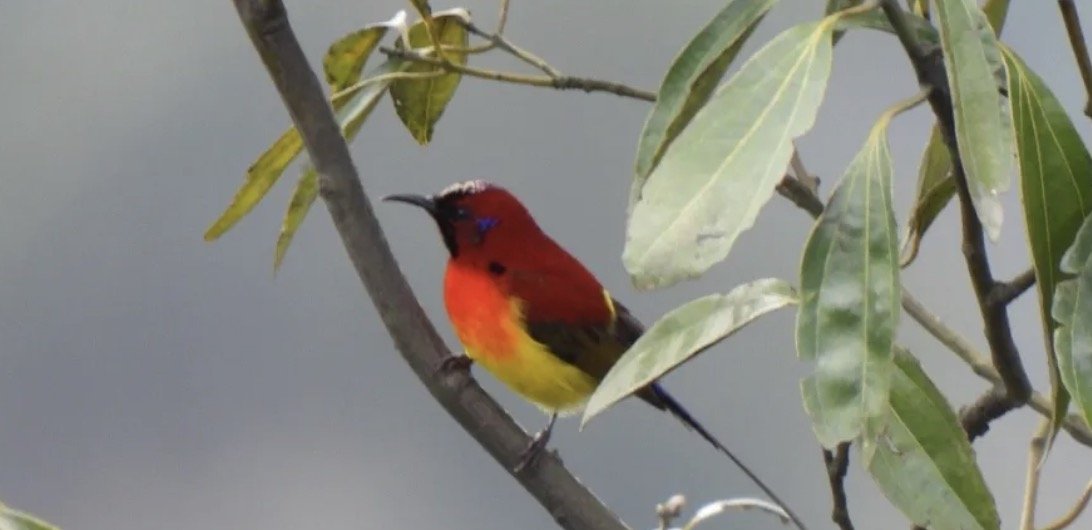🦅4.27 Raptor Station: My Experience at Dutongyan
For the past three weeks, I have served as a behind the scene editor/ data analyst mostly, but I also stayed at Dutongyan to serve as a raptor monitor for almost a week.
When we look back on the happy days in life, it seems like we often remember them as sunny, even though they might not have been. I checked the weather on the day we went to Dutongyan and confirmed it was actually cloudy. Yet, I can still feel the warmth of the sunlight on my face during the journey. We first arrived at the farmhouse where we were staying and enjoyed a meal of delicious home-cooked food made by the owner. Everyone kept complimenting the dishes while shoveling food into their mouths, occasionally making sounds of obvious, though unclear, approval. After we were full and happy, we began our mountain adventure. Although it was meant to be an acclimation day, while ascending to the viewing platform and bravely climbing the 990 steps, we suddenly heard the loud calls of cranes. When we turned around, we saw a breathtaking sight: a large group of black-necked cranes migrating in a V-formation. This surprise encounter felt like the perfect introduction to Dutongyan.
The excitement from that first day, something worthy of being featured on national television, filled us with anticipation for the days to come. On the second day, we didn’t spend the whole day on the mountain. In the afternoon, we went into town to buy supplies for the volunteer accommodation and did some cleaning. The dust and sweat mingled together as we worked, and as the place gradually became clean, we felt a deep sense of peace and satisfaction, knowing that this would be our cabin while we protected the birds of prey. It seems that love is always accompanied by unexpected surprises—during half a day of birdwatching, we spotted the first Greater Spotted Eagle migrating over Longmen Mountain this year, as well as the first Western Marsh Harrier ever recorded in this area. The first time seeing a large bird of prey up close had such an overwhelming impact that for the next two days, my mind kept replaying the sight of the eagle’s powerful, majestic wings gliding through the air.
Aside from the surprise of meeting the birds of prey at Dutongyan, our bird identification skills improved rapidly. When we first arrived, we were total beginners, but we were determined to expand our knowledge base. Every night we would review the day, compare notes, and constantly flip through field guides for extra practice. We didn’t just focus on birds of prey; we also made sure to observe the forest birds, determined to surpass the number of species observed at Longquan Mountain, which was far ahead at the time. By the third day, we were amazed at how much we had progressed. At first, we had to ask our teacher, Mr. Sha, “So, what’s the difference between a Crested Goshawk and a Common Buzzard?” and felt nervous whenever a bird appeared. But by the third day, we could easily distinguish between a Common Buzzard, a Sparrowhawk, and a Crested Goshawk without needing to look at pictures, realizing just how far we had come. Every time we lowered our binoculars and confidently named a species, our voices would lift with pride. My thoughts would jump between “Wow, I really am a natural talent” and “A hardworking girl can never go wrong.”
Each day spent with the birds of prey felt anything but boring. Even the journey up the 990 steps became enjoyable. Every step felt like a greeting to the birds we were about to see, as if the bridge between humans and birds was growing stronger. It reassured me that with each step forward, we were helping to protect more birds of prey from harm. The weather in the mountains is unpredictable, but during the week we were there, most of the days were perfect, as if the mountain itself was showing us love. Every day, we climbed the mountain under the dawn sky, and in the evening, we returned to our small cabin with the setting sun.
We watched the tender buds on the spring trees gradually grow and open, and the mountain flowers bloomed in vibrant and varied patterns. Sunbirds and various warblers hopped between the branches. This wasn’t just a mountain—it was a paradise for all living things.
As the peak of the migration season approached, our excitement was mixed with a bit of heaviness. Dutongyan has long been a hotspot for poaching, especially during the spring and autumn migration seasons. This was the very reason we came to protect the birds of prey here. Now, I am an observer, recorder, and witness to this paradise. Slowly, every action I take is becoming that of a guardian. I hope human activities do not cause disturbance and that this paradise can remain joyful forever.







